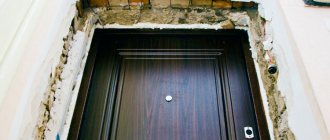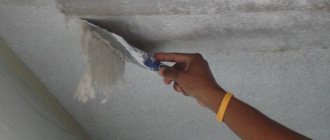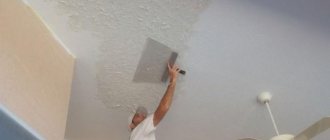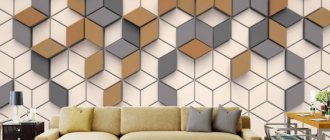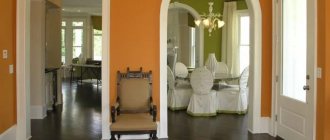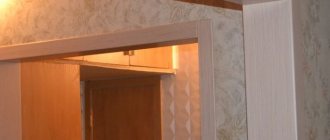The quality of a major renovation of an apartment and the durability of the finishing coating are largely determined by the order of work performed (this thesis fully applies to new buildings, where apartments are rented without finishing). In this regard, builders adhere to the golden rule: first the ceiling is finished, then the walls, and only after that the floor is laid , although Russians are accustomed to doing everything the other way around: half-wall-ceiling, and then deal with difficulties head-on. This is clear. How to plan work if it relates to walls? For example, what comes first - wallpaper or doors?
Let us immediately note that neither among specialists nor among those who carried out repair work on their own, there is no consensus on this matter: some believe that wallpaper needs to be glued first and give reasons for their point of view, others - on the contrary, that doors first, and then wallpaper.
Let's try to critically evaluate all the pros and cons and figure out whether they glue wallpaper first or install interior doors.
Main nuances
From the above rule, the sequence of actions is unclear - should you install the door first or hang the wallpaper? In the case of entrance doors, their installation should be provided for at the very first stages of repair. In the case of interior doors, the opinions of finishers and door installers are concentrated around the following facts:
- The easiest way: install a turnkey door, hang wallpaper and cover it with wide decorative trim. In this way it is possible to hide the trim line of the wallpaper, but thereby the aesthetics are lost. This method will not work if the door is installed close to the partition.
- If the repair process involves pouring screed at one level throughout all rooms, then installing the door leaf is done last. Depending on the design of the door, decorative elements are installed before or after installing the hinges, which means that wallpapering the walls will have to be completed before the final installation of the door.
If you plan to pour a concrete screed in one level, then installing the door frame should be done last, otherwise errors are inevitable that cannot be hidden either behind wallpaper or platbands Source Nikastroy.ru
Ceiling finishing
You have already become familiar with the fact that doors or wallpaper come first. But this knowledge is not enough to carry out quality repairs. You will also need to select materials. As for the ceiling, suspended structures are the most popular. Among their main advantages are:
- a light weight;
- ease of installation;
- long service life;
- environmental friendliness;
- ease of care.
But the main advantage is the speed of installation. The main rule when working with such ceilings is fastening after wallpapering.
Video description
At what stage of repair are doors installed?
- If you use wallpaper for painting, it is more convenient to install the door after painting.
- As work progresses, the humidity in the room rises. If doors made of non-laminated solid wood (for impregnation) are used, their installation is carried out after wallpapering and drying the room. This is done to avoid swelling of the door leaf. This advice does not apply to all other types of doors: those made of laminated solid wood or filled with corrugated cardboard.
- When installing expensive doors, it is better to play it safe and install them after all finishing work has been completed.
Ventilation device
Installation of utilities is perhaps one of the most important stages of repairs. But, as practice shows, not many people pay due attention to it. For a comfortable stay, the cooking area and bathroom must be equipped with a ventilation system and air exhaust, and the main room must be equipped with air conditioning. It is recommended to carry out installation work in the following sequence:
- The layout of the apartment is determined.
- Openings are made in the interior partitions.
- Installation of the external and external air conditioner unit is in progress.
- Ventilation is being installed.
- Electrical wiring is supplied to the devices.
Once you are done with this, you can start decorating the interior of the premises.
Wallpaper first
Anyone who has glued wallpaper at least once in their life knows how difficult it is to do it around the door. Pasting the corners will look like flowers. A free opening from the door frame is a definite plus when doing the work yourself.
Wallpapering should be done after all the “dirty” work has been carried out, while the installed doors should be gradually covered with plastic film Source Rerate.ru
Trimming wallpaper immediately after gluing is not an easy task. When installing a cheap door, there is a risk of delamination of the materials of the door frame and leaf when wet wallpaper comes into contact with its surface.
Maintaining verticality in uneven corners
This is especially important if the wallpaper has a geometric pattern that must match. There is a proven method for maintaining verticality. When wallpapering, you should mark a new vertical line on each wall using the method described above. In this case, the last strip of wallpaper on one wall will overlap the first fragment on the second by several centimeters.
Video description
When should interior doors be installed?
The “first wallpaper, then doors” method also has disadvantages:
- Installing a door is a messy and dusty process. After installation is complete, the wallpaper will have to be washed, and in the worst case, vacuumed.
- When forming the desired geometry of a doorway in a concrete wall, damage to the wallpaper is inevitable. If there are defects, the concrete may fall off in large pieces.
- No one is safe from human mistakes. Incorrect measurements, negligence of the door manufacturer and other factors lead to the fact that in some cases the doorway has to be reduced. After building up with a cement-sand mixture, an additional, unpasted wall surface appears, very different in color from concrete. Most often, decorative trims cannot cover this deficiency. There is a need for puttying and additional wallpapering, and with them a lot of difficulties: adjusting the pattern, a large number of scraps, etc.
- When finishing a doorway, it is almost impossible to avoid splashes of cement-sand mixture and other materials. Unlike dust, such contaminants are very difficult to remove. In addition, some door models do not have trim, which means you will have to tear off the wallpaper around the perimeter of the opening to form a solid corner.
To wallpaper a room with old doors, you need to remove the trim and restore the corners of the doorway to allow the work to be completed with the highest quality and accuracy Source Remontnik.ru
What to do if the interior door is larger or smaller than the doorway
The proportionality of the doorway and the door block largely determines how correctly they are installed and how long they will last. But if the sizes do not match, they are larger or smaller, how to correct this situation?
Widening the door opening - just from the side
How can you increase the doorway? The first thing you should pay attention to is the type of walls. If it's a wall, there won't be any problems.
- If the wall is load-bearing, it is important to prevent the ceiling from collapsing from above, creating an emergency situation and causing casualties.
- If there is a wall, the solution to the problem is described below. Which one to choose is chosen individually in each specific case.
How can I widen the opening? Just complete a series of activities.
- Strengthen the top of the opening. This point can be skipped if the expansion is wide, and then by no more than 100 mm, 50 mm on each side.
- Next is the marking. Having calculated exactly the width of the new door opening, markings are applied to the wall using a pencil or marker.
- Next comes the removal of unnecessary material in the opening - a hammer and sledgehammer, an angle grinder, and so on. Exceptional physical strength.
Everything is quite simple, but only in appearance - it is important to entrust all the work to the masters.
Reducing the doorway - possible variations
For some, work such as reducing a doorway may seem simple, but on the other hand, this, for the most part, leads to many problems if done incorrectly. And, first of all, these are cracks in the wall itself, and then – loosening of the door block.
- How can you reduce the door opening by no more than 100 mm? Such gaps are simply distributed on both sides of the doorway - regardless of the material of the walls, you can insert a batten or board of appropriate thickness into the free space. Alternatively, you can reduce it using plaster or drywall - reducing such volumes will not be difficult.
- If the opening is more than 100 mm? And for the most part, many craftsmen today use drywall. This is a technologically simple solution and a fairly clean technique, but it does have one drawback - the doors slam and can damage the structure by causing cracks to appear on its surface. And therefore a more reliable solution is to lay bricks.
Doors first
Proponents of the “doors first, then wallpaper” method give a generalized, powerful argument: installing a door is a rough job, and gluing wallpaper is a finishing job. According to the general principle of performing repairs, rough work is performed first. There are other arguments:
- Bare walls allow you to install doors quickly and without the need to constantly monitor the condition of the wallpaper.
- When carrying out repairs on a large site, pre-installation of doors allows you to isolate further work. Dust from one room can interfere with finishing work in another.
- Defects in the doorway that arose during the door installation process can be completely hidden without deteriorating the appearance.
- High-quality doors (with the exception of non-laminated solid wood) are not afraid of fluctuations in humidity in the room, which means they will not swell and will not warp.
When performing finishing repairs without installing doors, it is necessary to cover all doorways Source Drive2.ru
Features of flooring
First, you should consider the features of some floor coverings. In most cases, when installing a new floor, its level changes. The difference in height between the draft and the final version can be several centimeters, this is especially noticeable when laying tiles; parquet and most carpets take about a centimeter.
The most popular material today is laminate. Naturally, when laying it, the height of the floor changes upward due to the thickness of the substrate and the fragment itself. Despite the ease of installation, if the door is already installed, problems may arise with the fit of the outer units.
Read How to update wooden interior doors
When installing the door, it is necessary to take into account the thickness of the floor covering
The question of what to install first: doors or linoleum is not as pressing as in the case of other coatings. This is due to the small thickness and ease of installation of linoleum. All joints and hems can be easily hidden using plinths and platbands, and excess can be trimmed with a simple knife.
Conclusion
The accumulated experience allows us to assert that the correct sequence of repairs will be “first – doors, then – wallpaper.”
The reasons for this lie not only in theoretical aspects, but also in the practical sense of this method:
- Construction dust has a completely different structure than household dust. If it gets on wet wallpaper, it is not possible to remove it, and after drying it turns out that it is very strongly stuck to the wallpaper.
- Repairs are most often carried out in stages. Before wallpapering, a lot of “dirty” work is done: plastering, puttying, grouting, etc. If there is no door in the room, then all the dirt will quickly spread to the neighboring clean rooms.
- There is no risk of damaging the wallpaper during the process of replacing or installing a door.
Wall painting option
What is the best thing to do if the walls are painted rather than papered? Here, too, it is better to first install the door frame, without the door leaf and trim. Then proceed to decorative finishing. Just first seal the cracks and arrange the platbands. In addition, the surface of the door frame should be covered with protective masking tape.
After the paint has dried, hang the canvas and install the trim. This technology reduces the risk of possible wood swelling, and damage to the door block is reduced to zero. In addition, the process of painting the wall near the platbands is greatly simplified.
Useful tips
Recommendations to help simplify the gluing process:
- It is better to paste wallpaper behind radiators and vertical heating pipes right away, while you have fresh energy, so as not to suffer later.
- Before work, you need to turn off the power to the apartment, remove the covers from the sockets in order to glue the canvas directly onto them. After the wallpaper has dried, the holes are carefully cut out and the socket housings are put back in place.
- You can seal uneven joints near the ceiling using borders.
- When working with external corners, it is good to use a special plastic corner that matches the color of the trim.
Choosing the right “reference point” and strictly vertical orientation of the stripes are the key conditions for an accurate and high-quality finish.
To calculate the cost of work, fill out the form below. It's fast, free and without obligation!
We will call you and discuss all the details in detail!
